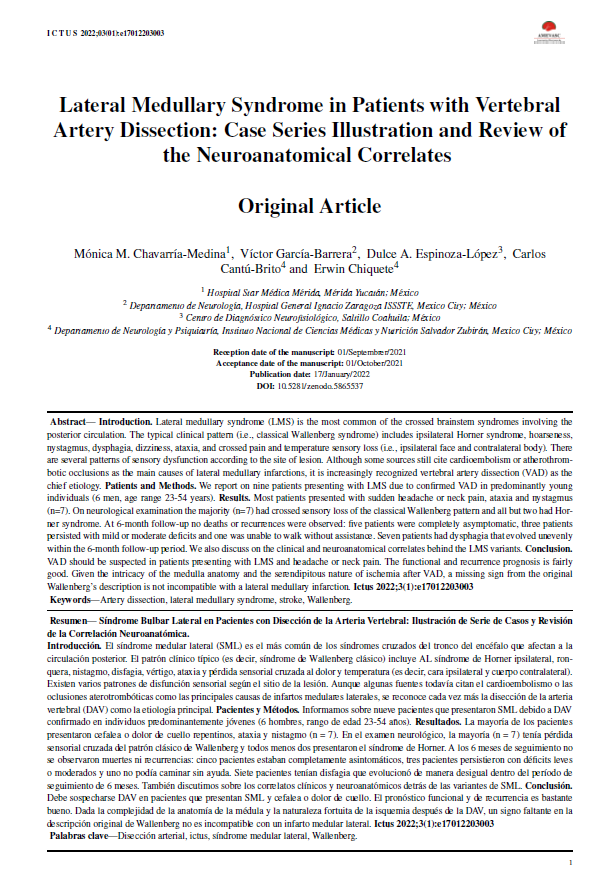Abstract
Introduction: Lateral medullary syndrome (LMS) is the most common of the crossed brainstem syndromes involving the posterior circulation. There are several patterns of sensory dysfunction according to the site of lesion. Although some sources still cite cardioembolism or atherothrombosis as the main causes of lateral medullary infarctions, it is increasingly recognized vertebral artery dissection (VAD) as the chief etiology.
Methods: We report on nine patients presenting with LMS due to confirmed VAD in predominantly young individuals (6 men, age range 23-54 years).
Results: Most patients presented with sudden headache or neck pain, ataxia and nystagmus (n=7). On neurological examination the majority (n=7) had crossed sensory loss of the classical Wallenberg pattern and all but two had Horner syndrome. At 6-month follow-up no deaths or recurrences were observed: five patients were completely asymptomatic, three patients persisted with mild or moderate deficits and one was unable to walk without assistance. Seven patients had dysphagia that evolved unevenly within the 6-month follow-up period. We also discuss on the clinical and neuroanatomical correlates behind the LMS variants.
Conclusions: VAD should be suspected in patients presenting with LMS and headache or neck pain. Given the intricacy of the medulla anatomy and the serendipitous nature of ischemia after VAD, a missing sign from the original Wallenberg’s description is not incompatible with a lateral medullary infarction.
References
Caplan LR. The intracranial vertebral artery: a neglected species. The Johann Jacob Wepfer Award 2012. Cerebrovasc Dis 2012; 34: 20–30.
Marx JJ, Thömke F. Classical crossed brain stem syndromes: myth or reality? J Neurol 2009; 256: 898–903.
Hydén D, Norrving B. Adolf Wallenberg (1862–1949). J Neurol 2005; 252: 1135–1136.
Pearce JM. Wallenberg's syndrome. J Neurol Neurosurg Psychiatry 2000; 68: 570.
Ross MA, Biller J, Adams HP Jr, Dunn V. Magnetic resonance imaging in Wallenberg's lateral medullary syndrome. Stroke 1986; 17: 542–5.
Rancurel G, Kieffer E, Arzimanoglou A. Vertebro-basilar ischaemic disease: one or more entities? 460 cases. Neurol Res 1992;14:174-6.
Sacco RL, Freddo L, Bello JA, Odel JG, Ongesti ST, Mohr JP. Wallenberg's lateral medullary syndrome. Clinical-magnetic resonance imaging correlations. Arch Neurol 1993; 50: 609–14.
Kim JS, Lee JH, Lee MC. Patterns of sensory dysfunction in lateral medullary infarction. Clinical-MRI correlation. Neurology 1997; 49: 1557–63.
MacGowan DJ, Janal MN, Clark WC, Wharton RN, Lazar RM, Sacco RL, Mohr JP. Central poststroke pain and Wallenberg's lateral medullary infarction: frequency, character, and determinants in 63 patients. Neurology 1997; 49: 120–5.
Affifi AK, Bergman RA. Functional neuroanatomy, text and atlas. New York, NY: McGraw-Hill; 1998.
Nakamura S, Kitami M, Furukawa Y. Opalski syndrome: ipsilateral hemiplegia due to a lateral-medullary infarction. Neurology 2010; 75: 1658.
Kon T, Funamizu Y, Ueno T, Haga R, Nishijima H, Arai A, Suzuki C, Nunomura J, Baba M, Tomiyama M. Dermatomal Sensory Manifestations in Opalski Syndrome. J Stroke Cerebrovasc Dis 2017; 26: e18–e19.
Shlobin NA, Mitra A, Prasad N, Azad HA, Cloney MB, Hopkins BS, Jahromi BS, Potts MB, Dahdaleh NS. Vertebral artery dissections with and without cervical spine fractures: Analysis of 291 patients. Clin Neurol Neurosurg. 2020; 197: 106184.
Yaghi S, Maalouf N, Keyrouz SG. Cervical artery dissection: risk factors, treatment, and outcome; a 5-year experience from a tertiary care center. Int J Neurosci 2012; 122: 40–4.
Müller MD, Seidel K, Peschi G, Piechowiak E, Mosimann PJ, Schucht P, Raabe A, Bervini D. Arterial collateral anatomy predicts the risk for intra-operative changes in somatosensory evoked potentials in patients undergoing carotid endarterectomy: a prospective cohort study. Acta Neurochir (Wien). 2020 Oct 24. doi: 10.1007/s00701-020-04624-y. Epub ahead of print.
Persad AR, Gould L, Norton JA, Meguro K. Uncrossed corticospinal tracts presenting as transient tumor-related symptomatology. Acta Neurochir (Wien). 2021 Jan 21. doi: 10.1007/s00701-020-04672-4. Epub ahead of print.
Silbert PL, Mokri B, Shieving WI. Headache and neck pain in spontaneous internal carotid and vertebral artery dissections. Neurology 1995; 45: 1517–1522.
Montalvan V, Ulrich A, Wahlster S, Galindo D. Arterial dissection as a cause of intracranial stenosis: A narrative review. Clin Neurol Neurosurg. 2020; 190: 105653.

This work is licensed under a Creative Commons Attribution 4.0 International License.
Copyright (c) 2022 Ictus

